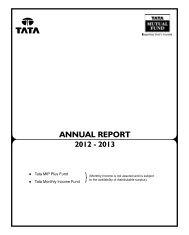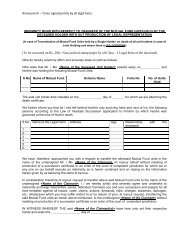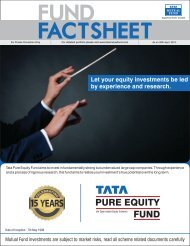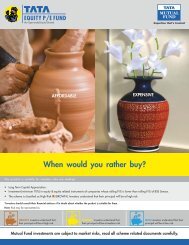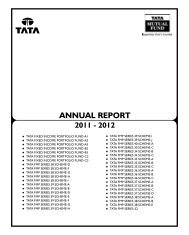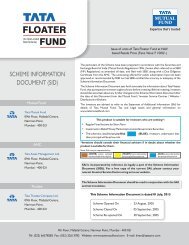Tata Fixed Tenure Fund Series - 2 Scheme B - Securities and ...
Tata Fixed Tenure Fund Series - 2 Scheme B - Securities and ...
Tata Fixed Tenure Fund Series - 2 Scheme B - Securities and ...
Create successful ePaper yourself
Turn your PDF publications into a flip-book with our unique Google optimized e-Paper software.
TATA FIXED TENURE FUND SERIES 2<br />
II. INFORMATION ABOUT THE SCHEME<br />
A. TYPE OF THE SCHEME<br />
A close ended Income <strong>Fund</strong>.<br />
B. INVESTMENT OBJECTIVE OF THE SCHEME<br />
The scheme seeks to generate income <strong>and</strong> / or capital appreciation by investing predominantly in wide range of Debt <strong>and</strong> Money Market<br />
instruments that are maturing on or before the maturity of the respective scheme. To attain capital appreciation, the scheme will invest small portion<br />
in equity/ equity related instruments.<br />
C. ASSET ALLOCATION AND RISK PROFILE<br />
Under normal circumstances, funds of the <strong>Scheme</strong>, shall (after providing for all ongoing expenses) generally be invested / the indicative asset<br />
allocation shall be as follows considering the objective of the <strong>Scheme</strong>:<br />
<strong>Tata</strong> <strong>Fixed</strong> <strong>Tenure</strong> <strong>Fund</strong> <strong>Series</strong> 2: <strong>Scheme</strong> B <strong>and</strong> <strong>Scheme</strong> A<br />
(Maturity of each scheme is 3 years from the date of allotment)<br />
Instruments<br />
Debt <strong>and</strong> Money Market<br />
Instruments, Securitised Debt*<br />
Equity <strong>and</strong> Equity related<br />
instruments<br />
Indicative allocations<br />
(% of total assets)<br />
Risk Profile<br />
Minimum Maximum High/Medium/Low<br />
80 100 Low to Medium<br />
0 20 Medium to High<br />
* The scheme may invest upto a maximum of 50% of the scheme’s net assets in domestic securitised debt. It includes investment in cash <strong>and</strong> cash<br />
equivalents securities.<br />
No investments would be made in foreign securitised debt.<br />
The schemes currently do not envisage to investment in foreign securities. Each scheme will have a separate portfolio.<br />
Not more than 25% of the net assets of the scheme shall be deployed in securities lending. The scheme would limit its exposure, with regards to<br />
securities lending, for a single intermediary to the extent of 5% of the total net assets of the scheme at the time of lending.<br />
The <strong>Scheme</strong> will have maximum derivative gross notional position of 50% of the net assets of the scheme. Investment in derivative instrument may<br />
be done for hedging <strong>and</strong> portfolio balancing.<br />
For calculation of gross derivative exposure, all types of derivative exposure i.e. long <strong>and</strong> short term will be aggregated. The aggregate exposure to<br />
debt instruments, gross derivative exposure, money market instruments (excluding CBLO, REPO <strong>and</strong> others cash equivalents instruments), equity<br />
<strong>and</strong> equity related instruments will not exceed 100% of the net assets of scheme.<br />
Not more than 25% of the net assets of the scheme shall be deployed in securities lending. The <strong>Scheme</strong> would limit its exposure, with regards to<br />
securities lending, for a single intermediary, to the extent of 5% of the total net assets of the scheme at the time of lending.<br />
The above Asset Allocation Pattern is only indicative. The investment manager in line with the investment objective may alter the above patterns for<br />
short term <strong>and</strong> on defensive consideration. The asset allocation among the various debt securities will be decided based upon the prevailing market<br />
conditions, macro economic environment <strong>and</strong> the performance of corporate sector, the debt market <strong>and</strong> other considerations.<br />
The AMC may in line with investment pattern of the scheme from time to time for a short term period on a defensive consideration invest upto 100%<br />
of the funds available in repos, CBLO etc. The primary motive being to protect the Net Asset Value of the <strong>Scheme</strong> <strong>and</strong> protect unitholders interest<br />
so also to earn reasonable returns on liquid funds maintained for redemption/repurchase of units.<br />
The investment policies mentioned in this SID are in conformity with the provisions of various constitutional documents VIZ.MOA/AOA of the<br />
TAML/Trustee Company, IMA <strong>and</strong> the Trust Deed.<br />
Any change in the asset allocation affecting the investment profile of the scheme shall be effected only in accordance with the provisions of<br />
regulations 18-15A of SEBI (Mutual <strong>Fund</strong>s) Regulations, 1996<br />
Change in Investment Pattern<br />
The Investment Pattern as outlined above is indicative. Investment strategy <strong>and</strong> pattern may be deviated from time to time, provided such<br />
modification is in accordance with the <strong>Scheme</strong> objective <strong>and</strong> Regulations as amended from time to time including by way of Circulars, Press<br />
Releases, or Notifications issued by SEBI or the Government of India to regulate the activities <strong>and</strong> growth of Mutual <strong>Fund</strong>s. The asset allocation<br />
pattern will be reviewed periodically. In case of any deviation, the AMC will endeavour to achieve a normal asset allocation pattern in a maximum<br />
period of one month. However, if such modified/ deviated portfolio is not rebalanced within a period of one month then justification for such delay<br />
will be provided to the trustees.<br />
Overview of Debt Market:<br />
The major players in the Indian Debt Markets are today are banks, financial institutions, insurance companies <strong>and</strong> mutual funds. The instruments in<br />
the market can be broadly categorized as those issued by corporate, banks, financial institutions <strong>and</strong> those issued by state/central governments.<br />
The risk associated with any investments are – credit risk, interest rate risk <strong>and</strong> liquidity risk. While corporate papers carry credit risk due to<br />
changing business conditions, government securities are perceived to have zero credit risk. Interest rate risk is present in all debt securities <strong>and</strong><br />
depends on a variety of macroeconomic factors. The liquidity risk in corporate securities market is higher compared to those of government<br />
securities. Liquidity in the corporate debt market has been improving due to the entry of more players <strong>and</strong> due to various measures taken by the<br />
regulators in this direction over a period of time. SEBI’s directive of a compulsory rating by a rating agency for any [public issuance over 18 months<br />
is a case in point. In times to come, dematerialization, entry of private insurance companies <strong>and</strong> growth of fixed income mutual funds are expected<br />
to enhance liquidity in corporate debt market.<br />
7




